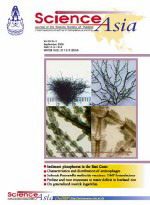ThaiScience
ThaiScience
SCIENCE ASIA
Volume 46, No. 05, Month OCTOBER, Year 2020, Pages 530 - 538
Molecular basis of cross-resistance in sagittaria trifolia l. against acetolactate-synthase inhibitors
Danni Fu, Bochui Zhao, Xiuwei Li, Songhong Wei, Mingshan Ji
Abstract Download PDF
Herbicide resistance to sulfonylureas in Sagittaria trifolia L. is a common problem in northern China. In our study, we used whole-plant dose-response, acetolactate synthase (ALS) sequencing, and ALS enzyme activity methods to assess 3 putative resistant (LN-1, LN-2, and LN-3) and one susceptible (S) S. trifolia populations for cross-resistance to ALS inhibitors (bensulfuron-methyl, ethoxysulfuron, pyrazosulfuron-ethyl, penoxsulam, pyribenzoxim, and bispyribac-sodium). Regarding the whole-plant dose-response and the in vitro ALS assays, the results showed that the LN-2 population evolved cross-resistance to all herbicides tested whereas the other two populations showed cross-resistance only to bensulfuron-methyl, ethoxysulfuron, pyrazosulfuron-ethyl, and penoxsulam. Results of the in vitro ALS assays were consistent with whole-plant dose-response data. The DNA sequencing of the ALS gene showed that LN-1 and LN-3 populations had a single nucleotide polymorphism in the Pro 197 codon, resulting in the substitution of proline (Pro) by serine (Ser) and leucine (Leu), respectively. However, the LN-2 population showed single nucleotide polymorphism in the second position of the Asp 376 codon, causing substitution of aspartic acid (Asp) by glutamic acid (Glu). The cross-resistance of the S. trifolia population to all ALS inhibitors due to Asp 376 mutation in the ALS gene of this species is reported for the first time
Keywords
target-site mutation, genetic analysis, sulfonylurea, triazolopyrimidine, pyrimidinyl-thiobenozoateSCIENCE ASIA
Published by : The Science Society of Thailand
Contributions welcome at : http://www.scienceasia.org/
